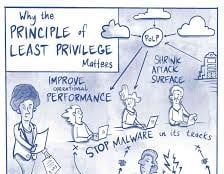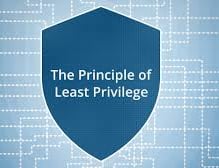Introduction
Think of the Least Privilege Principle as giving someone the smallest key possible to do their job. In cybersecurity, it means restricting user access to only the information necessary for them to complete their tasks. By applying this principle, businesses can minimize the impact of a compromised account and prevent unauthorized access to sensitive data.
Abstract
Overview
The Least Privilege Principle is an access control concept that limits a user's access rights to the bare minimum. This reduces the attack surface, ensuring that if an account is compromised, the intruder gains access to minimal information. With the rise of AI, this principle can be enforced more efficiently, offering dynamic and real-time access control.
The Least Privilege Principle is a fundamental cybersecurity practice that minimizes the potential damage caused by compromised accounts. By ensuring users only have access to what they absolutely need, you dramatically reduce the risk of security breaches. In this blog, we’ll explore how this principle works, its importance, and how AI can help enforce it with greater efficiency.


[Disclaimer: This blog post is for informational purposes only and should not be construed as legal or financial advice. Organizations should consult with legal counsel and regulatory authorities to ensure compliance with reporting requirements.]
Mandatory
Implementing the Least Privilege Principle is mandatory for securing digital systems and preventing unauthorized access to critical information. It’s a core tenet of good security hygiene.
Applicability
This principle applies to every organization handling sensitive or private data, from government agencies to private enterprises and healthcare institutions.
Regulatory or Company Interest?
Regulations like GDPR, HIPAA, and PCI-DSS emphasize access controls, including the Least Privilege Principle, to safeguard personal and financial information.
Key Guidelines
Restrict access to only necessary data and resources
Use dynamic access controls powered by AI to adjust privileges as needed
Regularly audit user permissions to ensure compliance with the least privilege model


Key Implications
Failure to implement the Least Privilege Principle increases the risk of data breaches, insider threats, and regulatory non-compliance. By applying this principle, organizations reduce the exposure of sensitive data and limit the damage caused by compromised accounts.
Countries with Adoption or Influence
Countries with stringent data protection laws like the US, UK, and the EU encourage the application of the Least Privilege Principle across all sectors, especially finance, healthcare, and government.
International Frameworks Influenced
International standards like ISO 27001 and NIST 800-53 emphasize the Least Privilege Principle as part of a comprehensive security strategy to protect sensitive information.
Regional and Industry-Specific Frameworks
Industries like healthcare (HIPAA) and finance (PCI-DSS) have specific requirements for the implementation of access controls that align with the Least Privilege Principle.
Secure Your Digital Identity with SecureKnots
Contact us to learn more about our cybersecurity services and ensure your organization meets cybersecurity requirements.


Conclusion
By applying the Least Privilege Principle, organizations can significantly reduce their risk profile and improve overall security. Implementing this principle is vital for protecting sensitive data and staying compliant with industry regulations.
How SecureKnots Can Help?
At SecureKnots, we help organizations implement the Least Privilege Principle through GRC consulting and security audits. Our VAPT services identify access control weaknesses, while our security awareness training educates employees on the importance of maintaining minimal access. Additionally, our ransomware and phishing simulations help test how well the principle holds up under attack. Let SecureKnots guide your access control strategy and ensure your systems remain secure.
This blog focuses on the importance of securing employee access to internal systems while showcasing how SecureKnots can help organizations strengthen their access controls. It is informative and engaging, highlighting the significance of Least Privilege Principle Let me know if you need further adjustments!
Thank you for your attention! If you have any inquiries about cybersecurity requirements or need expert guidance, please don't hesitate to contact SecureKnots.
This should wrap up the blog and fulfill the promise made in the previous one!
Least Privilege Principle-Only the Basics, Please
Ever heard of the least privilege principle? It’s like giving someone the smallest key possible to get their job done. By only granting users access to the bare minimum of information they need, you limit the damage if their account ever gets compromised. In upcoming blogs, we’ll dive into how Generative AI can help implement this principle, making sure you don’t give too much access to the wrong person.
WITH OUR SHORT BLOGS
STAY UP TO DATE
Copy Rights @ 2023 SecureKnots. All Rights Reserved.
CONTACT US
Contact@Secureknots.com
USA
+1-302-601-2346
+1-302-608-6708
INDIA
080-31658865
GET IN TOUCH
